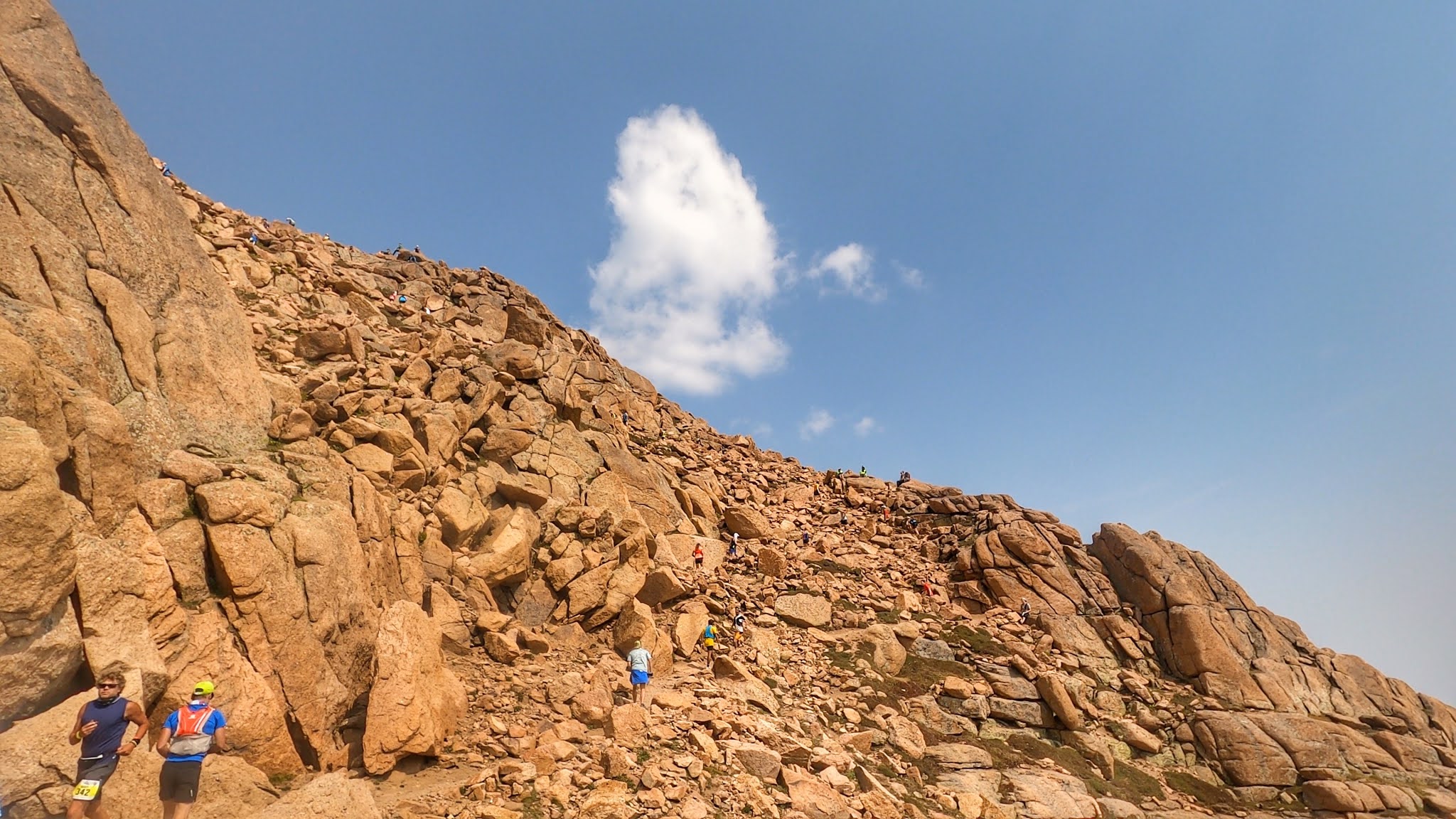To be honest, I'm mainly writing this race report to share some of the images of this amazing landscape. Quite frankly, my brain was way too oxygen deprived for 75% of this race to really come up with an enthralling blow by blow. After all, the Pikes Peak Marathon takes its runners from downtown Manitou Springs just outside Colorado Springs, CO at 6,400 feet over 13.1 miles up 7,800 feet to over 14,000 feet at the summit of Pikes Peak before sending us all the way back down the way we came.
I flew into town, Colorado Springs to be exact, on Friday evening, less than 36 hours before the race start. Usually, it is suggested to arrive within less than 24 hours of a race start at high altitude races or to give yourself at least 10-14 days of arrival time prior to race day to get somewhat acclimated to the high altitude. However, arriving 2 weeks early that doesn't mean that a "flatlander" (runner that usually lives and trains near sea level) suddenly has the ability to process oxygen in similar fashion than a local living at high altitude. Instead, you are hopefully able to at least avoid the most common symptoms of a lack of high altitude acclimation, namely headaches, lightheadedness, dizziness, nausea, etc. In other words, you will still feel like you're breathing through a straw, but you will do so without a severe headache, vomiting or passing out...hopefully.
In all seriousness, I was more nervous before this race start than any of the 100 milers I had run in previous years. After running the Leadville 100 last year and Never Summer 100K a couple of years earlier, I was quite familiar with the affects of high altitude during an endurance event. It basically reduces my endurance to about 70% of my max performance due to limited oxygen supply to my muscles. Locals have an advantage as their bodies have adjusted to the high altitude over several months or years to produce more red blood cells for the transport of oxygen to their muscles, hence improving their performance.
Needless to say, I knew my performance would suffer and progressively get worse as we climbed higher throughout the first half of the race. It was just a matter of how badly it would be affected. I started the race extremely conservatively. Due to Covid, most if not all pre and post race activities were cancelled. In addition, the field was divided into 9 waves with about 75 runners each to minimize the risk of spreading the virus. In addition, runners were required to wear masks prior to the race start and to keep a mask with them for entering aid stations during the race. I was lined up in the third wave. To compensate for the delayed star times, the race was chip timed at the start and finish line to keep all things equal.
If you asked me, locals should be forced to carry a 50 lbs backpack to really make things equal, but I digress:-) The first wave started at 7AM and 2 minutes later, I had crossed the start line slowly shuffling up the streets of Manitou Springs until we finally entered the Barr Trail that would take us all the way to the summit of Pikes Peak. Along the way, we would have access to aid stations with water, gatorade and different food items at regular shorter intervals that are more common to road marathons than mountain trail races. As a result, runners can afford to run without a pack or any supplies, if they so choose.I, on the other hand, opted to treat this race more like a trail 50K, wearing hydration vest to hold one bottle of fluids, salt, some Spring gels and my little GoPro camera to commemorate the event.
I decided to start slow and get slower and to hydrate all the way. The getting slower part definitely materialized, especially over the final 2 miles to the top. It turned into a slow slog to the top as oxygen became more and more scarce. I was excited to finally make it to the summit of Pikes Peak, the official halfway point of the race.
After briefly catching my breath I started my return trip down the mountain. Unfortunately, my pace did not seem to get much faster. It took much longer than expected to feel like myself again. As a result of the oxygen deprivation, I had to keep my pace very conservative to prevent tripping on the many roots or rocks on the trail. Overall, the trails were pretty smooth, but this wasn't just all the buffed out single track that the west coast is known for. I had to be very much aware of the terrain to avoid a head first plunge down the mountain.
To my surprise, I managed to stay upright all the way down, but at a much slower pace than expected. Every time I stopped for aid, my legs would buckle underneath me. I still do not know why, but I assume it was due to the high altitude. Thankfully, I was able to hold it together while still managing to look around to "smell the roses" (aka smoke of the second largest wildfire in Colorado history). After a punishing descent, I managed to cross the finish line of the Pikes Peak Marathon in one piece and with my dignity still intact, happy to have completed another one of my bucket list races.
While I did miss out on the traditional pre race activities and post race party with complementary beers from the race sponsors, I will remember this as one of the more challenging bucket list races I've completed so far.
Below is a video from the race:





















0 $type={blogger}:
Post a Comment